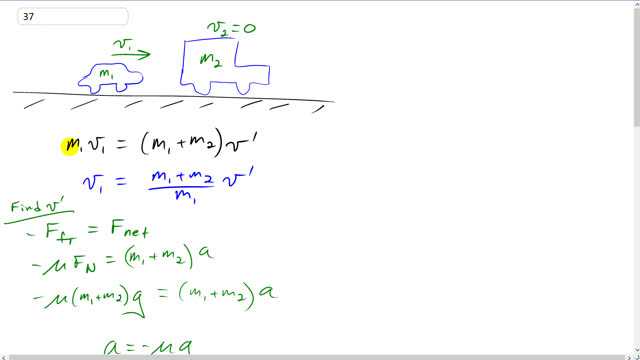
A 980-kg sports car collides into the rear end of a 2300-kg SUV stopped at a red light. The bumpers lock, the brakes are locked, and the two cars skid forward 2.6 m before stopping. The police officer, estimating the coefficient of kinetic friction between tires and road to be 0.80, calculates the speed of the sports car at impact. What was that speed?

In order to watch this solution you need to have a subscription.
This is Giancoli Answers with Mr. Dychko. Even though kinetic energy is not conserved because the collision here is inelastic, momentum is conserved so the momentum before the collision is m 1v 1 where m 1 is the mass of the car that's approaching from behind and v 1 is its velocity; there's no momentum from this parked SUV because its velocity is zero so the total momentum before the collision is just this. And then after the two collision, the two objects stick together so we have m 1 plus m 2 multiplied by their common speed v prime and we can solve for v 1— this is the velocity of the car before the impact— and it's gonna be m 1 plus m 2 all divided by m 1 times v prime. So in order to answer this question, we need to figure out what v prime is; this is the velocity that they begin to have just after the collision is done so when they are a single item—their bumpers are locked together— what velocity do they launch off with? Eventually they come to a stop after they skid 2.6 meters but what velocity do they begin with after they are stuck together? That's what we are gonna find now. So we'll talk about forces; the net force is gonna be the force of friction because there are no other horizontal forces and you know, there's no vertical forces, no net vertical forces because there's gravity down and there's equal normal force up and so on. So I put a minus sign here because this friction force is directed to the left opposing velocity and we are taking to the right to be positive. So we have negative μ times normal force— that's the friction— is gonna be the net force which is the total mass, m 1 plus m 2, times acceleration and it's gonna be negative μ times m 1 plus m 2 times g the normal force upward is gonna equal gravity downwards since there's no acceleration vertically and that equals m 1 plus m 2 times a and this gives us the acceleration or you might call it the deceleration that they have as they are skidding after the collision and that's gonna be useful in this formula where we know that the final velocity squared is initial velocity squared plus 2ad and final velocity is zero; initial velocity, this velocity is v prime— it's not the initial, initial velocity— it's not the velocity of the car before collision instead this is the velocity at the beginning of the skid after the collision and that's v prime and that's what we have to figure out here in order to plug in there. So v f is 0, v initial is v prime, and so we have v prime squared equals negative 2ad, bring this to the left side and switch the sides around. And take the square root of both sides and substitute for a which we figured out before is negative μg and so v prime is gonna be the square root 2μgd; d is the distance they skid. And copying this formula for v 1 down here, it's m plus M over m times v prime and substitute in the v prime that we just figured out here and we get that the velocity of the car before the impact is the sum of the mass of the car and the SUV divided by the mass of the car times square root of 2 coefficient of friction times acceleration due to gravity times the distance skidded. So that's 980 kilograms plus 2300 kilograms divided by 980 times square root 2 times 0.80 times 9.80 meters per second squared times 2.6 meters skidding and that gives 21 meters per second must have been the initial velocity of the car before the collision.